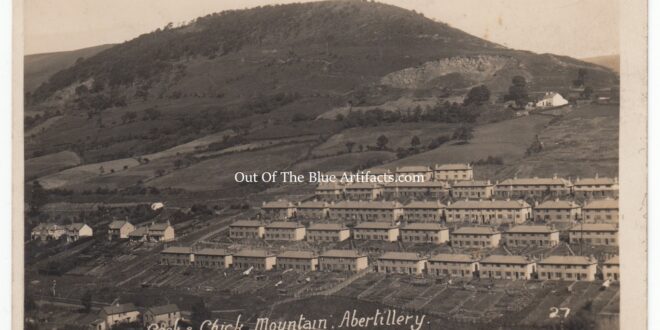Rose Heyworth Housing Scheme.
The Rose Heyworth Housing Scheme was being debated as early as 1901, a few years later the planning was given and the go-ahead was given by the council as part of the “Housing for the Working Classes Programme” within the Housing for the Working Classes Act Part III. Two fields at Clyn Mawr were being laid out by Mr A. P. Williams in preparation for building purposes. The land in question was believed to have been owned by the Nantyglo and Blaina Company Ltd and leased by Mr Jones of Brecon and negotiations over the purchase of land started.
In 1904 the planning and construction of the new cemetery at Brynithel had begun and the council was given a good price on land purchase along its route and they planned to build new houses under the Housing Act along Cemetery Road as that location was seen as more central and beneficial to the workmen and their families in the lower part of town. This proposed development was later abandoned in favour of the Clyn Mawr Housing Scheme.
On Tuesday 16th of January 1905, the Housing of the Working Classes Committee met at the Council Offices, Abertillery. The committee consisted of the following – Mr E. J. Williams (Chairman); Mr A. C. Willis; Mr G. Little; Mr F. Athay and Mr W. Harris: At this meeting a letter was read from Mr Theo Vatchell stating the land at the rear of the Intermediate School Abertillery in the occupation of Mr Jones of Brecon, did in fact belong to Messrs J. R. and T. A. Webb of Aberbeeg. The clerk of the committee was asked to write to Mr Vachell and ask him to supply a plan showing the intended two sites for development of the Rose Heyworth Estate with all access roads leading to and from such. It was stated the rents would be £8. 15s. 0d. and £9. 10s. 0d. per annum.
In March 1905 Mr Theo Vachell communicated with the council with regard to the purchasing of land at Clyn Mawr and the council could not agree to the terms. Mr Vachell would not agree to their terms and the scheme was dropped. The original proposal to build houses along Cemetery Road was again raised though that idea was also abandoned. The next monthly meeting of the Housing of the Working Classes Committee was adjourned.
The Need for Housing after the Great War.
After the Great War 1914-1918 the need for housing was again in the forefront of the local authority’s development plans in the country a part of the Housing Act of 1890-1919. Within this Act every authority had to provide housing for the working classes in their districts. The houses were to be erected according to plans already approved by the Housing Commissioner and the construction was closely monitored. The procedure, if the builders were to agree to help them, was that when quantities were priced, a three-party conference would be called and the prices discussed. The houses would be allocated by the builders themselves according to their resources. The idea was to erect 1,470 houses in three years and a housing committee was set-up.
The Council and Builders Conference.
On Wednesday 21st of January 1920, a joint conference of members of the Abertillery Urban District Housing Committee and members of the Ebbw Vale and District Master Builders Association, which includes Abertillery and Blaina, was held at the Council Chamber, Queen Street. The Following gentlemen attended – Mr J. Carter; Mr J. Morrell; Mr J. T. Boots; Mr J. Snellgrove; Mr D. Thomas; Mr James Williams; Mr G. Daggar and Mr L. Elliott (all members of the Abertillery Urban District Council) with Mr T. B. Smith (Medical Officer); Mr L. D. Lewis (Surveyor); Mr F. Padfield (Sanitary Inspector); Mr E. R. L. Henderson (Assistant Surveyor); Mr E. W. Jones (Accountant); Mr W. Gait (Clerk) and Mr D. R. Davies (Deputy Clerk): The Master Builders Association included – Mr C. H. Miles (Chairman); Mr Robert Hall; Mr W. Mills; Mr A. Bennett; Mr R. Tudor; Mr S. Meaker; Mr E. Collier and Mr J. Snell: Mr Griffiths attended as (Regional Architect) in lieu of the Housing Commissioner.
The Rose Heyworth Scheme was for 40 houses, which had already been approved, ten different classes were in the scheme embracing three different types. Mr Tudor said the builders agreed to give the council their full support for the erection of 40 said houses. The building was to start at once and the meeting of the various parties would take place at Cardiff in the following February. The clerk reported communication had been made with the Ministry of Health in regard to a loan for the purchase of land and legal costs for the transfer. With reference to the Housing Scheme at Rose Heyworth, the Ministry of Health forwarded their sanction for the borrowing of £8,500 for the purchase of land on Rose Heyworth Road as a building site and £350 for stamp duties. The amount was repayable over 80 years.
On Wednesday 11th of February 1920, a meeting of the Abertillery Urban District Council and Building Operatives was held at the Council Chamber to discuss problems with council funding for the erection of the 40 houses at Rose Heyworth. Mr Snellgrove said the council were faced with paying 5 and a half percent, they had not settled the loan question and they could not afford or pledge themselves to provide plant for the builders. The problems with manpower were also raised, many builders had gone to work elsewhere as there was no work in the building trade, at this time it was stated the pay on the building site was £4. 2s. 3d. per week and a week’s work in that trade could not be guaranteed. The council closed the meeting and invited the operatives back at a later date.
The surveyor for the Abertillery Urban District Council received a communication regarding a cheap way to construct houses. The procedure was on a Dorman-Long plan, he later stated they had inspected houses built on the Dorman-Long plan in various stages of erection and had decided to adopt this new method of building with a ground structure of solid concrete.
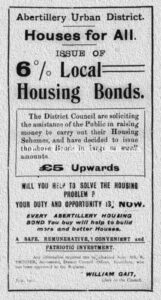 The Housing Bonds Campaign.
The Housing Bonds Campaign.
In July 1920 a Housing Bonds Campaign began at Abertillery, a meeting was held at the Tabernacle Schoolroom presided by Sir Thomas Hughes (Chairman of the Welsh Board of Health). It was stated that there was to be a model village at Rose Heyworth, taking in 122 acres of land with over 700 houses being built. There was already 40 ready to be commenced. At this point in time, it seems Abertillery District Council had a loan of £50,000 sanctioned for the erection of houses in the district, with model villages being planned for Sofrydd and Crumlin as well as Rose Heyworth Road. The Bond Scheme would add extra money to the fund though it was reported that not much interest was being shown in the purchasing of such bonds.
In June 1920 the Abertillery Urban District Council put out tenders for the appointment of clerk of the works to oversee the erection of the houses on the Rose Heyworth Estate. The wage was stated as being £5. 10s. 0d. per week, equivalent to £270. 00 in today’s money.
The First Batch of Houses.
On Friday 16th of July 1920, it was reported that the construction of the first batch of 40 houses in connection with the Rose Heyworth Housing Scheme were to begin. If the proposed Housing Bond Scheme was successful more houses would be built.
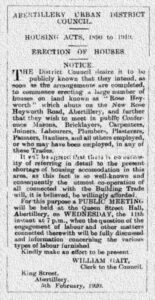 The Contracts and Fees.
The Contracts and Fees.
The tenders for the contracts for the various house buildings at Rose Heyworth were accepted and were given to the following builders – Mr Richard Tudor (6 houses two blocks £5,657. 0s. 3d). Mr Robert Hall (4 houses two blocks £3,892. 8s. 6d.). Mr Ernest James Collier (4 houses two blocks £3,901. 2s. 11d.). Mr William David Mills (4 houses two blocks £3,898. 18s. 3d.). Mr Albert Bennett (6 houses two blocks £5,848. 9s. 10d.). Mr George Reginald Smith (6 houses two blocks £5,664. 4s. 8d.). Messrs Sidney Meaker, Stanley Meaker and Edward Meaker trading as the Meaker Bros (6 houses two blocks £5,602. 7s. 5d.) and Mr John Snell (4 houses 1 block £3,726. 18s. 11d.). The construction of 100 Dorman-Long houses was approved and the costs of the respective classes were £832, £948 and £1,08 each. The appointment of clerk of works was voted on, out of nine applicants two were selected, Mr Jack J. Williams and Mr Herbert D. Prosser, after a vote the position was given to Mr Herbert D. Prosser.
Mr Henry Smith.
On Thursday 4th of November 1920, a serious accident occurred at the Abertillery District Council’s stone quarry at Rose Heyworth, Mr Henry Smith of Gladstone Street, Abertillery and Mr John Jukes of Coed-Cae Tilla Farm, Abertillery were employed by the council to open out the quarry for stone to use in the construction of the houses at Rose Heyworth, taking off the topsoil and felling trees. One of the trees fell on the men and Mr Smith was severely injured. Dr T. B. Smith the council’s medical officer and Nurse Mason were called to the scene. Mr Smith was taken to the Royal Gwent Hospital in the Motor Ambulance belonging to Messrs John Lancaster & Co while Mr Jukes was taken home.
In May 1921 it was reported that Mr Henry Smith had passed away as a result of the injuries he had sustained at the quarry 6 months earlier.
In November 1920 it was reported that the houses being constructed under the Rose Heyworth Housing Scheme were in good progress and that the council had received more than 300 applications from prospective tenants for the houses. The council wanted to adopt some method of selecting the tenants and stated that ex-servicemen and their families would have priority. It was also intimated that another batch of houses were to be constructed south of the ones in progress and that the council wanted to build them with their own labour and staff rather than through a third party.
In March 1921 the Abertillery Urban District Council received a letter from the housing commissioner stating in his opinion the rents charges of 7s. 6d. and 10s 11d. laid out by the council were regarded as insufficient for the type of houses being constructed. He set out new charges of £1. 1s. 2d., £1. 6s. 11d. and £1. 10s. 2d.
In April 1921 it was reported that all houses had to be completed before July 1922 in order to rank for a government subsidy under the State-Aided Housing Scheme.
The Second Batch of Houses.
In May 1921 the Abertillery Urban District Council invited tenders for the erection of another batch of 40 houses at Rose Heyworth. To be sent to Clerk of the Council Mr William Gait at the Council Offices, Abertillery, Mon. Later a problem arose when the housing commissioner did not sanction the construction of the said 40 houses as he thought the tenders were in excess of the cost they were prepared to sanction. He could only sanction 24 houses subject to the tenders being satisfactory. The surveyor drew up amended plans for 24 houses with a hope of receiving sanction for 29 and issued new tenders for 24 houses to be constructed.
In November 1922 after a long-drawn-out procedure over the tender contracts and planning of the additional 24 houses at Rose Heyworth, it was reported that the Abertillery District Council were in disagreement with the National Builders Guild Ltd. The contracts could not be signed as many disagreements between the guild and the Abertillery Council arose. Later the tender of Messrs Hybart and Broadhead & Co Ltd was accepted for the sum of £8,379 for the construction of the 24 additional houses.
In April 1923 it was reported that the government introduced a new Housing Bill, the scheme was “To pay to any authorities a subsidy of £6 per house of only non-parlour type for 20 years, the authority to pay any further loss out of their rates”. It was seen as not unfair on larger cities as they had high rateable values and commanded high rents and borrow at a less of amount of interest, it seemed this scheme would be unfair on the council of Abertillery and of South Wales as a whole.
In June 1923 the clerk wrote to the Minister of Health requesting permission to include in the present contract of 24 houses at Rose Heyworth an additional 14 houses, these extra houses would be the same design as previously built and would occupy the whole of the site adjacent to the intermediate school. The request was refused under the Government Assisted Scheme. The council did not accept the decision and moved that they approach the ministry’s representative at Cardiff. At this time there were over 1,000 applications to the council from prospective tenants for the new houses.
In the same month, June 1923 the council heard that Messrs Bennett and Gilson had planned to reopen their coal levels on Clyn Mawr and wanted to lease land that was part of the Rose Heyworth Housing Scheme and belonged to the council, both parties agreed yet the ministry upon hearing of the proposed lease refused to grant the request. They would only accept a sale of the freehold land with certain conditions. Messrs Bennett and Gilson agreed to the new terms.
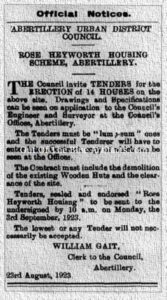 The Third Batch of Houses and the Demolition of the Wooden Huts.
The Third Batch of Houses and the Demolition of the Wooden Huts.
In August 1923 the Abertillery Urban District Council held a meeting to discuss the communication from Messrs Tudor and Elliott, their representatives at Cardiff in regard to the requesting of an additional 14 houses to be constructed at the Rose Heyworth site and Mr Charles Ruthin and other Officers of the Ministry of Health refused to comply, it was proposed by Mr Tudor and seconded by Mr Boots to press ahead on their own and issue tenders for the additional 14 houses in question. The clerk issued tenders for the construction of such houses, the tenders included a condition that the successful contractor must demolish and remove the remaining wooden huts on the site.
The Wooden Huts.
The Wooden Huts, Houses, officially called Rose Heyworth Cottages were constructed in the mid 1870’s. Each house contained a scullery, living room and two bedrooms all on one floor, they consisted of 12 houses divided into 3 blocks of four, in a field adjacent (north) to the intermediate school. They were thought to have been originally constructed for the sinkers at Rose Heyworth Colliery, though after the sinking operations finished the colliery company let the cottages to the workmen as tenants.
At the time the huts were built they were placed a fair distance apart from each other as a fire-safety precaution. In April 1893 Mrs Margaret Perrott was badly burnt when an oil lamp was tipped over at her house in the Wooden Houses and in April 1911 a fire broke out at Messrs Flook’s home, the first block closest to the colliery, two boys Leonard Flook and William Henry Flook were sadly killed in the inferno. Their neighbours in the other houses in the block were – Messrs Meek’s, Perrott’s and the Jones’. The ensuing fire engulfed the whole block of 4 houses, the other families escaped without injury. The other blocks were occupied and stayed as such until the early 1920’s when the council deemed them unfit for habitation, they were condemned and demolished when the new houses were built.
The Wooden Houses position were under the gardens of what would become numbers 25, 30 and 36 Morley Road.
Lady Members on the Council’s Housing Committee.
In August 1923 the council discussed the appointment of lady members, a vote was taken where seven members were in favour with six against. The following ladies were then appointed to attend meetings of the housing committee – Mrs Dolman, Abertillery; Mrs A. F. Handy, Six Bells; Mrs Small, Cedar Villa, Commercial Road, Llanhilleth and Mrs Lewis of Richmond Road, Abertillery.
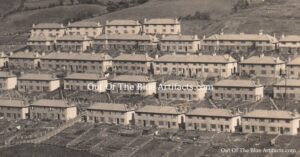 The Estate.
The Estate.
The Morley Road, Rose Heyworth Road and Smith Road houses, all part of the Rose Heyworth Housing Scheme can be seen completed in the image (right).
The Level Crossing at Morley Road.
In October 1925 communication began between the Great Western Railway Company and the Abertillery Urban District Council as to the proposal to construct a level crossing from the Abertillery Park to Morley Road.
Morley Road Cricket Team.
In the mid 1920’s the male residents of Morley Road, Abertillery formed a cricket team and entered into the league, games were played on the Park Extension Grounds, Abertillery. The cricket team consisted of the following gentlemen – Mr B. Axford; Mr R. Chapman; Mr R. Robins; Mr E. Stanfield; Mr W. Gray; Mr H. Dyer; Mr L. James; Mr A. Purnell; Mr F. Morgan; Mr S. Howells and Mr F. Gibbs: By June 1930 other members included – Mr H. Wilkins; Mr G. Cook; Mr Gowan; Mr Green; Mr C. Gibbs; Mr Hoare and Mr D. Howells:
Morley Road Football Team.
In the early 1930’s the male residents of Morley Road were in the Association Football League at Abertillery. Their team was called Morley Road United.
 Out Of The Blue Artifacts A Library of a lifetime of collecting
Out Of The Blue Artifacts A Library of a lifetime of collecting
